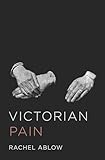Victorian Pain / Rachel Ablow.
Material type: TextPublisher: Princeton, NJ : Princeton University Press, [2017]Copyright date: ©2017Description: 1 online resourceContent type:
TextPublisher: Princeton, NJ : Princeton University Press, [2017]Copyright date: ©2017Description: 1 online resourceContent type: - 9780691174464
- 9781400885176
- English literature -- 19th century -- History and criticism
- Human body in literature
- Literature and science -- Great Britain -- History -- 19th century
- Literature and society -- Great Britain -- History -- 19th century
- Pain in literature
- Pain -- Great Britain -- History -- 19th century
- LITERARY CRITICISM / Modern / 19th Century
- 820.9353 23
- PR468.P15 A26 2018
- online - DeGruyter
- Issued also in print.
| Item type | Current library | Call number | URL | Status | Notes | Barcode | |
|---|---|---|---|---|---|---|---|
 eBook
eBook
|
Biblioteca "Angelicum" Pont. Univ. S.Tommaso d'Aquino Nuvola online | online - DeGruyter (Browse shelf(Opens below)) | Online access | Not for loan (Accesso limitato) | Accesso per gli utenti autorizzati / Access for authorized users | (dgr)9781400885176 |
Browsing Biblioteca "Angelicum" Pont. Univ. S.Tommaso d'Aquino shelves, Shelving location: Nuvola online Close shelf browser (Hides shelf browser)

|

|

|

|

|

|

|
||
| online - DeGruyter Classical Greek Oligarchy : A Political History / | online - DeGruyter The Peace of the Gods : Elite Religious Practices in the Middle Roman Republic / | online - DeGruyter Strange Vernaculars : How Eighteenth-Century Slang, Cant, Provincial Languages, and Nautical Jargon Became English / | online - DeGruyter Victorian Pain / | online - DeGruyter Getting Tough : Welfare and Imprisonment in 1970s America / | online - DeGruyter Chosen Nation : Mennonites and Germany in a Global Era / | online - DeGruyter The First Serious Optimist : A. C. Pigou and the Birth of Welfare Economics / |
Frontmatter -- Contents -- Acknowledgments -- Introduction. Pain, Subjectivity, and the Social -- Chapter One. John Stuart Mill and the Poetics of Social Pain -- Chapter Two. Harriet Martineau and the Impersonality of Pain -- Chapter Three. Pain and Privacy in Villette -- Chapter Four. Charles Darwin's Affect Theory -- Chapter Five. Wounded Trees, Abandoned Boots -- Afterword. The Fantasy of the Speaking Body -- Notes -- Words Cited -- Index -- A Note On the Type
The nineteenth century introduced developments in science and medicine that made the eradication of pain conceivable for the first time. This new understanding of pain brought with it a complex set of moral and philosophical dilemmas. If pain serves no obvious purpose, how do we reconcile its existence with a well-ordered universe? Examining how writers of the day engaged with such questions, Victorian Pain offers a compelling new literary and philosophical history of modern pain.Rachel Ablow provides close readings of novelists Charlotte Brontë and Thomas Hardy and political and natural philosophers John Stuart Mill, Harriet Martineau, and Charles Darwin, as well as a variety of medical, scientific, and popular writers of the Victorian age. She explores how discussions of pain served as investigations into the status of persons and the nature and parameters of social life. No longer conceivable as divine trial or punishment, pain in the nineteenth century came to seem instead like a historical accident suggesting little or nothing about the individual who suffers.A landmark study of Victorian literature and the history of pain, Victorian Pain shows how these writers came to see pain as a social as well as a personal problem. Rather than simply self-evident to the sufferer and unknowable to anyone else, pain was also understood to be produced between persons-and even, perhaps, by the fictions they read.
Issued also in print.
Mode of access: Internet via World Wide Web.
In English.
Description based on online resource; title from PDF title page (publisher's Web site, viewed 23. Mai 2019)


